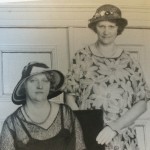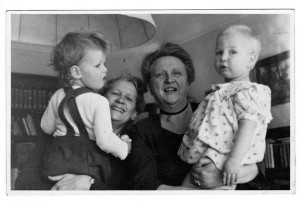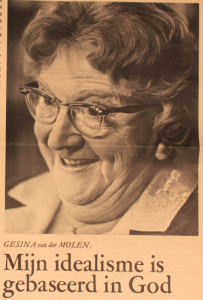by Robin Hendriks and Marlinde Venema
A newspaper correction might seem like one of the most mundane things imaginable, but this correction provides insight into one particular relationship: that between Gesina van der Molen and Mies Nolte.

Lives and careers
Gesina (1892-1978) and Mies (1899-1986) met in the late 1920s, started living together in 1930, and would continue to do so for the rest of their lives. During the Second World War they were active in the Dutch resistance in Amsterdam, with Gesina being a founding member of both Vrij Nederland and Trouw. She was no stranger to activism. Gesina came from a reformed protestant and politically active family. Her father was a member of parliament and later a mayor, and Gesina herself had flirted with the pacifist and feminist movement at the time of the First World War. She was vocal about women’s rights to work especially, and earned her own money. After a short time training as a nurse, she went to the Vrije Universiteit in Amsterdam to study law, and would be the university’s first female PhD candidate. Ultimately she would hold a position as professor of law at the VU, and after the war she worked for the OPK, an organization which took responsibility for Jewish orphan children. Gesina identified her religion as a driving force behind her work, with fairness and justice taking a central position. After the war, Mies pursued her own PhD in history and was involved in local government. But for all of their political engagement and activism, Gesina and Mies never publically talked about or acknowledged their relationship.

A public secret
The fact that they were together was a public secret, to such an extent that
in an interview Mies’s niece Marianne says she does not believe her aunts were lesbian. But historical evidence points to a romantic relationship between Mies en Gesina. Jan van der Molen, Gesina’s father,
called Mies his ‘youngest daughter.’ Piet Meerburg, a fellow resistance worker, said he knew immediately that Gesina was lesbian, and old student and friend of Gesina’s, Pieter Kooijmans, described her relationship with Mies as ‘very intimate and warm.’
In 1943 Mies and Gesina even threw a special party to celebrate the fact they had been together for 12.5 years; one of the only times they publically acknowledged their relationship. After the war they would never bring attention to their relationship like this again. They kept to a strict code of conduct that included not showing physical affection, and their niece Marianna actually says one of the biggest reasons she does not believe they were in a relationship is that they never showed physical affection. Aside from their celebration of 1943, they only broke this code when travelling abroad.

Private life
It is clear that people close to them knew the nature of Mies en Gesina’s relationship. This becomes especially apparent in letters Gesina exchanged with Anita Lebeson, a historian and American colleague of the OPK. In the late 1940s and early 50s, Anita and Gesina developed a good friendship over paper correspondence and meetings in America and Europe. Mies and Anita also got to know each other, and in the letters Gesina and Mies exchanged with Anita and her husband Hermon, it is apparent that their American friends knew the nature of their relationship. The letters tell a story of two couples corresponding with each other as couples.


In their private life, Gesina and Mies were a couple. They might not have stated it explicitly, but it was clear to people they knew and trusted. This stood in stark contrast to how Gesina presented herself in her public life.

Public life
Gesina was a public figure, both as a professor and a Christian. She was not afraid to stand up to authority and stand up for other people’s rights. But she was full of inconsistencies: although she fought for women’s right to work, she thought married women should stay at home; she fought tooth and nail against the discrimination of Jewish citizens during the war, but was later accused of commiting cultural genocide with her work for the OPK – she gave priority to Jewish children staying with the families that had fostered them for years over taking them from those families to be raised by Jewish families. But she never started a fight for her rights as a lesbian women. It would have seriously damaged her professional life, and Gesina was an ambitious carreer woman. We don’t know if she thought she should have any rights as a lesbian woman, considering her reformed christian worldview. Moreover, in their daily lives Gesina and Mies were part of communities that they would have lost if they had advocated for their relationship. For someone who zealously propagated a Christian way of life and who described herself as a servant of God, a ‘lesbian scandal’ would not do.
The correction
This brings us back to the correction which appeared in the Algemeen Handelsblad on April 20, 1962. The handwriting in the margin is Mies’s, and adds a personal touch. The clipping comes from the archive of Gesina’s belongings that Mies herself collected and donated to the Vrije Universiteit after her partner’s death. There are no real personal items to be found in it, but with this correcting we meet Mies and Gesina at an intersection of private and public life. They are mentioned in their professional capacities, and explicitly stated to be living together. Did they laugh at the mistake of the newspaper? Was there resentment that someone had gotten an important part of their lives so wrong? We can’t know. But what we do know is that to Mies, at least, this clipping was important enough to keep and donate to the VU. It might just be that she did this because it was a very tangible but plausibly deniable proof of her relationship with Gesina, and that makes it a perfect symbol of their relationship, as well as an example of how many people have lived and still live their lives.
Back to gallery
Further reading:
M. Freeburg and S. Hamming, Profiel: Gezina van der Molen (documentary, 2007).
G. van Klinken, Strijdbaar en omstreden (Amsterdam 2006).
Marijke Waalkens, Molen, Gezina van der, in: Digitaal Vrouwenlexicon van Nederland.
